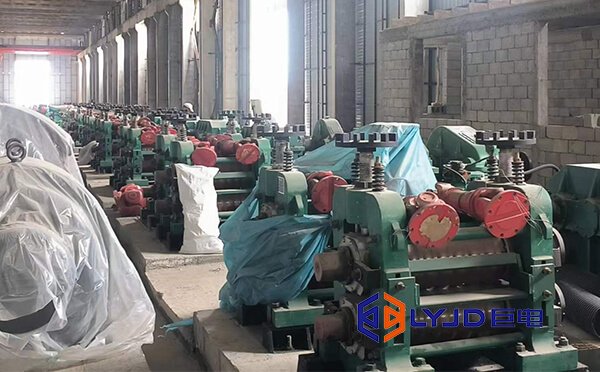A continuous rolling mill is a steel rolling equipment used to continuously roll metal raw materials into finished products of various shapes and sizes. It consists of multiple frames, each frame is equipped with two upper and lower rollers, and the distance between the upper and lower rollers can be adjusted to adapt to metal materials of different thicknesses and materials.
The working principle of the continuous rolling mill is to put the metal raw materials into the heating furnace in front of the hot rolling mill and heat them to reach the appropriate temperature and softness. Then, the metal material is fed into the rolling mill, undergoes a series of plastic deformations under the continuous action of multiple stands, and is finally rolled into the required finished product shape and size.
Continuous rolling mills are widely used in the production of various metal products, such as steel pipes, steel plates, steel sections, bars, wire rods, etc., with the advantages of high production efficiency, stable product quality, energy saving, and environmental protection.

Pros and Cons of Continuous Rolling Mill
Pros
High Productivity
The continuous rolling mill can continuously roll metal materials, improving production efficiency.
Stable Product Quality
During the continuous rolling process, the metal material undergoes a series of plastic deformations, resulting in more uniform deformation and finer grains, thereby improving the quality of the product.
Energy Saving
The continuous rolling mill can reduce rolling energy consumption and save energy.
Wide Range of Applications
Continuous rolling mills can produce various specifications and types of metal products to meet different market demands.
High Degree of Automation
Continuous rolling mills can adopt automated control systems and technologies to reduce labor costs and labor intensity and improve production efficiency and quality.
Cons
High equipment cost
The continuous rolling mill equipment is complex and the manufacturing and installation costs are high.
Difficult To Operate and Maintain
Due to the complexity of the continuous rolling mill equipment, it requires professional operation and maintenance, and regular equipment inspection and maintenance is required.
Higher Requirements for Metal Raw Materials
Continuous rolling mills have high requirements for metal raw materials and require certain pretreatment and adjustments before rolling.
Long Adjustment Time
The adjustment time of the continuous rolling mill is long, and it requires multiple processes and frame adjustments to produce metal products that meet the requirements. The adjustment process is relatively complicated.
Greater Impact on the Environment
During the operation of the continuous rolling mill, noise, vibration, and high temperature will be generated, which will have a certain impact on the surrounding environment.
To sum up, the continuous rolling mill has the advantages of high production efficiency, stable product quality, and energy saving, but it also has the disadvantages of high equipment cost and difficulty in operation and maintenance.
Continuous Steel Rolling Production Line Components
Rolling line
Mainly consists of a steel billet heating furnace, billet opening machine, rolling mill, control flying shear, and other equipment. The heating furnace is used to heat the steel billet to the appropriate temperature, the billet opener is used to cut the heated steel billet into the required shape, the rolling mill is used to roll the steel billet into the required size and shape, and the controlled flying shear is used to cut the unused steel billet. Qualified steel.
Finishing Line
Depending on the type of finished product, it can be composed of straighteners, cut-to-length shears, cooling beds, various benches, inspection beds, and other equipment. Straighteners are used to adjust the curvature of steel. Cut-to-length shears are used to cut steel to the required length. Stackers are used to stack steel together. Various types of cooling beds and racks are used for transportation and storage of steel. The inspection table is used to check the quality of steel.
Auxiliary equipment
In addition, the continuous steel rolling production line also requires auxiliary equipment such as billet warehouses, finished product warehouses, cranes, and balers. The billet warehouse is used to store steel billets to be processed. The finished product warehouse is used to store processed steel. The crane is used to move equipment and materials within the factory. Balers are used to pack steel into bundles for shipping.
Generally speaking, the continuous steel rolling production line is a complex and orderly system. Only the coordinated work of various equipment can achieve the efficient operation of the entire production process.
How to Use Continuous Rolling Mill with Continuous Casting Machine?
The continuous rolling mill and the continuous casting machine can be used together to achieve full continuous production of metal products. Specifically, the slab produced by the continuous casting machine can be directly fed into the continuous rolling mill for rolling, which can achieve a seamless connection between the casting and rolling processes.
To ensure that the continuous casting machine and the continuous rolling mill can be used together smoothly, the following points need to be noted:
The cross-section specifications and output of the slab should match the raw materials and product specifications required by the rolling mill, and a certain compression ratio should be guaranteed.
The production capacity of the continuous casting machine should be slightly larger than the steelmaking capacity, and the steel rolling capacity should be slightly larger than the continuous casting capacity (for example, about 10% larger), so as to ensure the matching relationship between output.
Continuous rolling mills and continuous casting machines should adopt automated control systems and technologies to achieve intelligent production, reduce labor costs and labor intensity, and improve production efficiency and quality.
To sum up, the combination of continuous rolling mills and continuous casting machines can realize the full continuous production of metal products, improve production efficiency and quality, and save energy and resources.